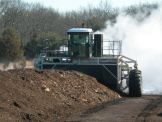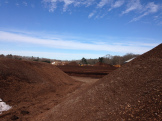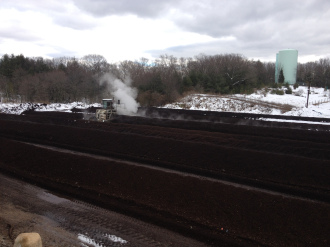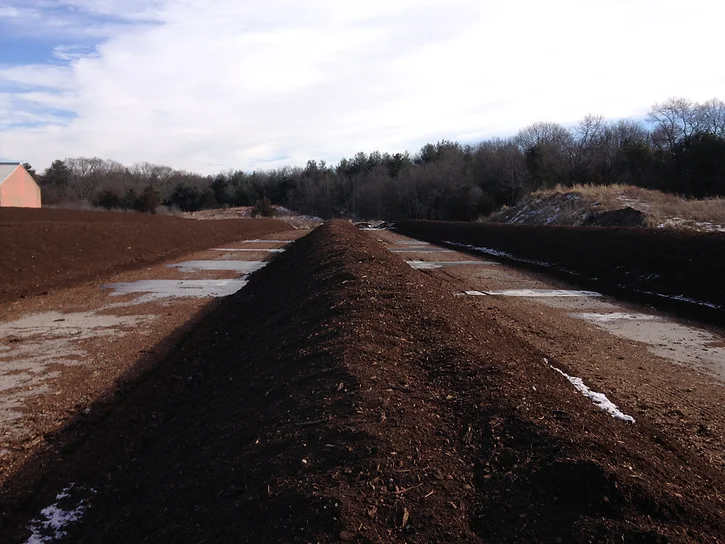- Tests for levels of toxic elements and compounds shall be performed by a private testing laboratory approved by the Engineer.
- Tests for soil chemistry and pH may be performed by an Agricultural Experiment Station testing laboratory or another testing laboratory approved by the Engineer.
Compost shall be a well-decomposed humus (organic) material derived from the aerobic decomposition of biodegradable matter, free of viable weed seeds and other plant propagules (except airborne weed species), foreign debris such as glass, plastic, etcetera and substances toxic to plants.
Compost shall be suitable for use as a soil amendment and shall support the growth of ornamental nursery stock and turf establishment.
Compost shall be in a shredded or granular form and free from hard lumps. Food and agriculture residues, animal manure, or other bio-solids that meet the above requirements and are approved by the Massachusetts Department of Environmental Protection are acceptable as source materials.
- The level of toxic elements and compounds in organic matter shall be below the Massachusetts Department of Environmental Protection Type I standards for sludge and the United States Environmental Protection Agency standards for Class A “Exceptional Quality Sludge”, whichever is more stringent.
- Levels of pathogens shall be below both federal and state thresholds.
- Composted material with an unpleasant odor, such as that of ammonia or fecal material shall be rejected by the Engineer.
- Compost shall have the following properties: – maximum particle size of 1 inch (25 mm) – stability = 6 using Solvita test kit.
The Solvita test kit shall be procured by the Contractor, and the compost samples shall be tested on site in the presence of the Engineer for the following:
- moisture content between 35-55 %
- pH range between 5.5 and 7.5
- minimum organic matter content of 40% (minimum dry weight)
- maximum electrical conductivity of 0.4 s/m
- maximum of 1 percent foreign matter
- C: N ratio range of 11-25:1
- *An extended list of commercial sources of compost material is available from the Division of Consumer Programs, Bureau of Waste Products, Massachusetts Department of Environmental Protection.
Today we will be discussing the “Organic Soil Additive” M106, used in compost top soil, and for compost filter “Mitts”, or compost berms (USEPA). Every contractor that performs work on Mass State land is required to meet these standards. These compost specifications have been derived by the US Composting Council a private entity. We would like to discuss these following items; the pathogen level, the Solvita test, the idea that each batch will be inspected by an approved engineer, and the whole concept of using criteria that is was generated by Private Enterprises and requires the public to comply with these specifications as the organic soil additive in governmental materials and sediment control devices? The goal for most “compost facilities”, whether private or government has been for the sole purpose of reducing solid wastes so municipal landfills will have adequate space for the storage of these wastes. The addition of specifications puts an additional burden on private and municipal solid waste facilities. The issue is that we all should be operating under the same criteria, if there are to be honest inspections and the costs that are required to meet these criteria are no longer allocated to solid waste reduction but to industrial manufacturing of an organic product that meets these defined criteria.
It may be assumed that by the decomposition of organic matter, not humus be performed as a thermophilic aerobic process in which the temperatures of the composted organic materials will reach the required temperature range to kill off any pathogenic organisms, and presumably most viable weed seeds excepting maybe tomato seeds?
Then maybe the daily temperature readings of the compost pile as it goes through its decomposition process is to be logged and reported until it becomes a “stable” material and does not spike – out temperature readings any more. These types of management procedures might be helpful when someone is asked to provide the information that is being called for in the M1.06.0 Organic Soil Additives’ specification.
We will be continuing this discussion in our following blogs, and we welcome any questions or comments that you may want to discuss!





